|
|
 |
|
Calanoida ( Order ) |
|
|
|
Calanoidea ( Superfamily ) |
|
|
|
Paracalanidae ( Family ) |
|
|
|
Acrocalanus ( Genus ) |
|
|
| |
Acrocalanus gracilis Giesbrecht, 1888 (F,M) | |
| | | | | | | Ref.: | | | Giesbrecht, 1892 (p.171, 175, 770, figs.F); Giesbrecht & Schmeil, 1898 (p.25, Rem. F); Thompson & Scott, 1903 (p.233, 243); Wolfenden, 1905 (1906) (p.1003, Rem., figs.F,M); A. Scott, 1909 (p.29); Wolfenden, 1911 (p.204); Sewell, 1912 (p.359); 1914 a (p.209); FrŘchtl, 1924 b (p.41); Mori, 1929 (p.172, figs.F); Sewell, 1929 (p.79, figs.F, p.87: Rem. M), fig.M); Dakin & Colefax, 1933 (p.205); Farran, 1936 a (p.81); Mori, 1937 (1964) (p.31, figs.F,M); Dakin & Colefax, 1940 (p.93, figs.F); Vervoort, 1946 (p.134, Rem.); Sewell, 1947 (p.53, Rem.); Tanaka, 1956 c (p.371, Rem. F,M, p.374: Rem.M); Tanaka, 1960 (p.27, figs.F, Rem.: abormality); Brodsky, 1962 c (p.116, figs.F); Kasturirangan, 1963 (p.24, fig.F); Shen & Lee, 1963 (p.574); Chen & Zhang, 1965 (p.45, figs.F,M); Vinogradov, 1968 (1970) (p.78); Kos, 1972 (Vol.I, figsF, Rem.); Greenwood, 1976 (p.18); Bj÷rnberg & al., 1981 (p.624, figs.F); Zheng & al., 1982 (p.28, Figs.F); Hiromi, 1987 (p.154); Nishida, 1989 (p.173, fig. 3, dorsal hump); Bradford-Grieve, 1994 (p.48, figs.F,M); Chihara & Murano, 1997 (p.846, Pl.136: F,M); Bradford-Grieve & al., 1999 (p.877, 909, figs.F,M); Conway & al., 2003 (p.154, figs.F,M, Rem.); Mulyadi, 2004 (p.174, figs.F, Rem.); Phukham, 2008 (p.117, figs.F); Gusmao & McKinnon, 2009 (p.1101, Table II, III, figs.F, M, sex ratio, intersex); Soh & al., 2013 (p.49, figs.F). | 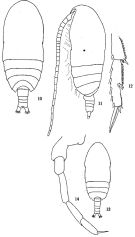 issued from: Q.-c Chen & S.-z. Zhang in Studia Marina Sinica, 1965, 7. [Pl.10, 10-14]. Female (from E China Sea): 10, habitus (dorsal); 11, idem (lateral left side); 12, distal segment of exopod of P4 (posterior). Male: 13, habitus (dorsal); 14, P5 (posterior).
|
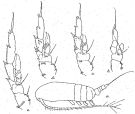 issued from : R.B.S. Sewell in Mem. Indian Mus., 1929, X. [p.79, Fig.31]. Female (from Nicobar Is.): a, habitus (lateral left side); b, P1; c, P2; d, P3; e, P4.
|
 issued from : T.E. Bowman in Bull. mar. Sc. Gulf Caribb., 1958, 8 (2). [p.119, Fig.1, E]. Female (from W Pacific equatorial): E, habitus (lateral).
|
 issued from : T. Mori inThe pelagic Copepoda from the neighbouring waters of Japan, 1937 (1964). [Pl.12, Figs.1-5]. Female: 1, habitus (lateral); 4, P1 (anterior); 5, P4 (posterior). Nota: The external margins of the 3rd exopod segment of P2 to P4 are denticulate. Male: 2, habitus (lateral); 3, P5. Nota: The right leg of P5 is vestigial or absent; left leg 5-segmented.
|
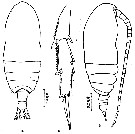 issued from : Z. Zheng, S. Li, S.J. Li & B. Chen inMarine planktonic copepods in Chinese waers. Shanghai Sc. Techn. Press, 1982 [p.28, Fig.15]. Female: a-b, habitus (dorsal and lateral, respectively); c, exopod of P4, P2 and P3. Scale bars in mm.
|
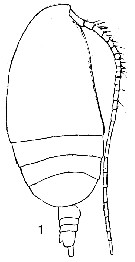 issued from T. Mori in Zool. Mag. Tokyo, 1929, 41 (486-487). [Pl. V, Fig.1]. Female (from Chosen Strait, Korea-Japan): 1, habitus (lateral).
|
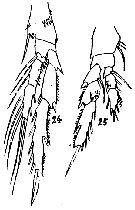 issued from T. Mori in Zool. Mag. Tokyo, 1929, 41 (486-487). [Pl. IV, Figs.24-25]. Female: 24, P4; 25, P2.
|
 Issued from : W. Giesbrecht in Systematik und Faunistik der Pelagischen Copepoden des Golfes von Neapel und der angrenzenden Meeres-Abschnitte. - Fauna Flora Golf. Neapel, 1892, 19 , Atlas von 54 Tafeln. [Taf. 10, Fig.35]. Female: exopodite 3 of P4.
|
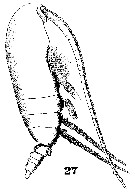 Issued from : W. Giesbrecht in Systematik und Faunistik der Pelagischen Copepoden des Golfes von Neapel und der angrenzenden Meeres-Abschnitte. - Fauna Flora Golf. Neapel, 1892, 19 , Atlas von 54 Tafeln. [Taf. 6, Fig.27]. Female: 27, habitus (lateral).
|
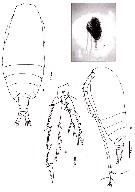 Issued from : N. Phukham in Species diversity of calanoid copepods in Thai waters, Andaman Sea (Master of Science, Univ. Bangkok). 2008. [p.199, Fig.73]. Female (from W Malay Peninsula): a-b, habitus (dorsal and lateral, respectively); c, P4. Body length after the drawing: F = 1.143 mm.
|
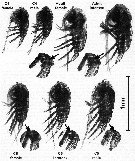 issued from : L.F.M. Gusmao & A.D. McKinnon J. Plankton Res., 2009, 31 (9). [p.1106, Fig.1].
Examples of different sexes in the last three stages of development of Acrocalanus gracilis raised in incubation in the Timor Sea.
Normal C4, C5 and adult females do not have P5, and only the basipodite can be seen. The P5 of C4 males is almost half the length of the urosome, and in C5 males the P5 is as long as the urosome. In C5 and adult intersex, P5 is as long as in the C4 males.
The authors propose that sex change is an important mechanism determining the adult sex ratio.
Sex ratios of Acrocalanus gracilis could be explained by sex change alone; the observations suggest that sex determination is under strong environmental control, and that the food limitation is an important determinant of sex change.
|
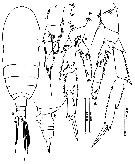 issued from : Mulyadi in Published by Res. Center Biol., Indonesia Inst. Sci. Bogor, 2004. [p.174, Fig.97]. Female (from Indonesian Seas): a, habitus (dorsal); b, posterior thoracic segments and urosome (lateral left side); c, P1; d, P3; e, P4.
|
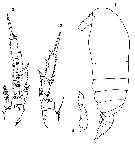 Issued from : O. Tanaka in Spec. Publs. Seto mar. biol. Lab., 10, 1960 [Pl. IX, 1-4]. Female (from Indian Ocean): 1, habitus (lateral); 2, P2; 3, P3. Abnormal female P5: 4. A female specimen measuring 1.22 mm had an abnormal P5 composed of 4 segments; the distal outer margin of the exopod of the P3 was furnished with very minute spines.
|
 Issued from : H.Y. Soh, S.Y. Moon & J.H. Wi in Invertebrate Fauna of Korea (eds) Incheon: NIBR, 2013, 21 (28). [p.50, Fig.28]. Female (from Korean waters): A-B, habitus (dorsal and lateral, respectively); C, forehead (ventral); D, P5. Scale bars: A, B = 200 Ám; C = 100 Ám; D, 25 Ám.
|
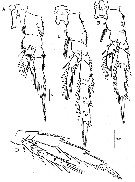 Issued from : H.Y. Soh, S.Y. Moon & J.H. Wi in Invertebrate Fauna of Korea (eds) Incheon: NIBR, 2013, 21 (28). [p.51, Fig.29]. Female: A, P1; B, P2; C, P3; D, P4. Scale bars: A = 50 Ám; B-D = 100 Ám.
|
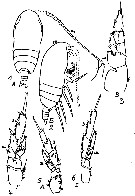 Issued from : M.C. Kos in Field guide for plankton. Zool Institute USSR Acad., Vol. I, 1972. After Brodsky, 1962. Female: 1-2, habitus (dorsal and lateral, respectively); 3, P1; 4, P2; 5, P3; 6, P4.
| | | | | Compl. Ref.: | | | Cleve, 1904 a (p.184); Carl, 1907 (p.16); Wilson, 1942 a (p.170); Sewell, 1948 (p.390, 395, 403, 407, 412, 422, 433); C.B. Wilson, 1950 (p.157); Krishnaswamy, 1953 (p.115); Chiba & al., 1957 (p.306); 1957 a (p.11); Yamazi, 1958 (p.147, Rem.); Fagetti, 1962 (p.13); Ganapati & Shanthakumari, 1962 (p.7, 15); Bj÷rnberg, 1963 (p.9); De Decker, 1964 (p.14, 17, 28); De Decker & Mombeck, 1964 (p.11); Fleminger, 1967 a (tabl.1); Delalo, 1968 (p.137); Timonin, 1971 (p.281, trophic group); Subbaraju & Krishnamurphy, 1972 (p.25, 26 ); Bj÷rnberg, 1973 (p.303, 384); Patel, 1975 (p.659); Carter, 1977 (1978) (p.35); Chen Q-c, 1980 (p.794); Dessier, 1983 (p.89, Tableau 1, 2, Rem., %); De Decker, 1984 (p.315, 328: carte); 1984 a (p.157); Guangshan & Honglin, 1984 (p.118, tab.); Binet, 1984 (tab.3); 1985 (p.85, tab.3); Almeida Prado Por, 1985 (p.250); Madhupratap & Haridas, 1986 (p.105, tab.1); Renon, 1987 (tab.2); Dessier, 1988 (tabl.1); Williams D. & al., 1988 (p.580); Echelman & Fishelson, 1990 a (tab.2); Hirakawa & al., 1990 (tab.3); Othman & al., 1990 (p.561, 563, Table 1); Hirakawa, 1991 (p.376: fig.2); Hernandez-Trujillo, 1991 (1993) (tab.I); Godhantaraman, 1994 (tab.5, 6); Shih & Young, 1995 (p.71); Gouda & Panigrahy, 1995 (p.206); Go & al., 1997 (tab.1); Park & Choi, 1997 (Appendix); Wong & al., 1998 (tab.2); Mauchline, 1998 (tab.45); Noda & al., 1998 (p.55, Table 3, occurrence); Hwang & al., 1998 (tab.II); Suarez-Morales & Gasca, 1998 a (p.110); Smith S. & al., 1998 (p.2369, Table 6, moonsoon effects): Dolganova & al., 1999 (p.13, tab.1); Ueda & al., 2000 (tab.1); Dalal & Goswami, 2001 (p.22, fig.2); McKinnon & Duggan, 2001 (p.121); Lo & al., 2001 (1139, tab.I); Hwang & al., 2003 (p.193, tab.2); Shimode & Shirayama, 2004 (tab.2); Hsiao & al., 2004 (p.326, tab.1); Hsieh & al., 2004 (p.397, tab.1); Rezai & al., 2004 (p.486, tab.2, 3, abundance); L0 & al. *, 2004 (p.218, tab.1); Lo & al., 2004 (p.468, tab.2); Chang & Fang, 2004 (p.456, tab.1); Lan & al., 2004 (p.332, tab.1, tab.2); Gallienne & al., 2004 (p.5, tab.3); Lo & al., 2004 (p.89, tab.1); Kazmi, 2004 (p.230, Rem.: p.232); Rezai & al., 2005 (p.157, Table 2: spatial & temporal variations); Shimode al., 2005 (p.113 + poster); Prusova & Smith, 2005 (p.75); Zuo & al., 2006 (p.159, tab.1, 3, abundance, fig.8: stations group); Lopez-Ibarra & Palomares-Garcia, 2006 (p.63, Tabl. 1, seasonal abundance vs El-Ni˝o); Hwang & al., 2006 (p.943, tabl. I); Hwang & al., 2007 (p.24); Dur & al., 2007 (p.197, Table IV); Jitlang & al., 2008 (p.65, Table 1); McKinnon & al., 2008 (p.844: Tab.1); Morales-Ramirez & Suarez-Morales, 2008 (p.521); Ayon & al., 2008 (p.238, Table 4: Peruvian samples); Lopez Ibarra, 2008 (p.1, Table 1: abundance, Table 2: Rem.); Fernandes, 2008 (p.465, Tabl.2); Ohtsuka & al., 2008 (p.115, Table 5); Lan Y.C. & al., 2008 (p.61, Table 1, % vs stations, Table 2: indicator species); Tseng L.-C. & al., 2008 (p.62, Table 2, fig.5, occurrence vs geographic distribution, indicator species); Tseng & al., 2008 (p.402, Table 2); Tseng L.-C. & al., 2008 (p.46, table 2, abundance vs moonsons, fig.8, table 3: indicator species); Pagano, 2009 (p.116); C.-Y. Lee & al., 2009 (p.151, Tab.2); Mendes Gusmao & McKinnon, 2009 (p.1089, development and production); Tseng & al., 2009 (p.327, fig.5, feeding); Lan Y.-C. & al., 2009 (p.1, Table 2, % vs hydrogaphic conditions); Cornils & al., 2010 (p.2076, Table 3); Hernandez-Trujillo & al., 2010 (p.913, Table 2); Sun & al., 2010 (p.1006, Table 2); Fazeli & al., 2010 (p.153, Table 1); W.-B. Chang & al., 2010 (p.735, Table 2, 3, 4, fig.5, abundance); Hsiao S.H. & al., 2011 (p.475, Appendix I); Hsiao & al., 2011 (p.317, Table 2, 3, fig.6, indicator of seasonal change); KÔ & Hwang, 2011 (p.155, Table 3: occurrence %); Tseng L.-C. & al., 2011 (p.47, Table 2, occurrences vs mesh sizes); Pillai H.U.K. & al., 2011 (p.239, Table 3, vertical distribution); Maiphae & Sa-ardrit, 2011 (p.641, Table 2); Beltrao & al., 2011 (p.47, Tabvle 1, density vs time); Jang M.-C & al., 2012 (p.37, abundance and seasonal distribution); Johan & al., 2012 (2013) (p.1, Table 1); Tseng & al., 2012 (p.621, Table 3: abundance, indicator species); Johan & al., 2012 (p.647, Table 1, fig.2, salinity range); Cornils & Blanco-Bercial, 2013 (p.861, Table 1, molecular analysis, figs.3, 4, 5); Palomares-Garcia & al., 2013 (p.1009, Table I, abundance vs environmental factors); in CalCOFI regional list (MDO, Nov. 2013; M. Ohman, pers. comm.); Varadharajan & Soundarapandian, 2013 (p.2: occurrence vs stations); Tachibana & al., 2013 (p.545, Table 1, seasonal change 2006-2008); Tseng & al., 2013 (p.507, seasonal abundance); Tseng & al., 2013 a (p.1, Table 3, 5, abundance); Jagadeesan & al., 2013 (p.27, Table 3, 4, 5, 6, fig.11, seasonal abundance); Anjusha & al., 2013 (p.40, Table 3, abundance & feeding behavior); Anjusha & al., 2013 (p.40, Table 3, abundance & feeding behavior); Mendoza Portillo, 2013 (p.37: Fig.7, seasonal dominance); Hwang & al., 2014 (p.43, Appendix A: seasonal abundance); Bonecker & a., 2014 (p.445, Table II: frequency, horizontal & vertical distributions); Lopez-Ibarra & al., 2014 (p.453, Table 2, biogeographical affinity); Dias & al., 2015 (p.483, Table 2, abundance, biomass, production); Nakajima & al., 2015 (p.19, Table 3: abundance); Rojas-Herrera & al., 2016 (p.40, Table 2: temporal abundance, Table 3: diversity index); Ben Ltaief & al., 2017 (p.1, Table III, Summer relative abundance); Ohtsuka & Nishida, 2017 (p.565, Table 22.1) | | | | NZ: | 15 | | |
|
Distribution map of Acrocalanus gracilis by geographical zones
|
| | | | | | | | | | | | 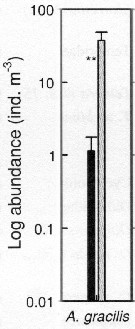 Issued from : S.-H. Hsiao, S. KÔ, T.-H. Fang & J.-S. Hwang inHydrobiologia, 2011, 666. [p.326, Fig.6]. Issued from : S.-H. Hsiao, S. KÔ, T.-H. Fang & J.-S. Hwang inHydrobiologia, 2011, 666. [p.326, Fig.6].
Variations in the most abundant copepod species (mean ▒ SE) along the transect in the boundary waters between the northern part Taiwan Strait and the East China Sea , March (black bar) and October (grey bar) 2005 (Mann-Whitney U test, sig. **P <0.01.
See drawings of Hydrological conditions and superficial marine currents in Calanus sinicus. |
| | | | Loc: | | | South Africa (E & W), Patagonia, Brazil (Campos Basin, ...), Cuba, Antilles, E Medit. (G. of Gabes), G. of Suez, G. of Aqaba, Red Sea, Gulf of Oman, G. of Aden, Arabian Sea, Maldives Is., Madagascar, Rodrigues Is. - Seychelles, Mascarene Basin, Natal, Indian, Sri Lanka (Pearl Banks), India (Saurashtra coast, W, SE coast, Porto Novo, G. of Mannar, Palk Bay, Madras, Rushikulya estuary, Lawson's Bay), Bay of Bengal, Nicobar Is., Barren Island, S Burma, W Malay Peninsula (Andaman Sea), Perai River estuary, Straits of Malacca, Indonesia-Malaysia, Ambon Bay, Bintulu coast, Tioman Is., SW Celebes, Timor Sea, Philippines, Viet-Nam (Cauda Bay), Hong-Kong, China Seas (Yellow Sea, East China Sea, South China Sea), Taiwan Strait, Taiwan (S, E, W, SW, Tapong Bay, Kaohsiung Harbor, NW, N, Mienhua Canyon, NE), Okinawa, S Korea, Korea Strait, Japan Sea, Japan ( Ariake Bay, Kuchinoerabu Is., Tokyo Bay, Seto Inland Sea), off SE Japan, Aleutian Is., Bering Sea, off Washington, California, Baja California (Bahia Magdalena), G. of California, Acapulco Bay, W Costa Rica, Clipperton Is., Pacif. (W equatorial), Australia (S, Great Barrier, Moreton Bay, North West Cape, G. of Carpentaria), New Caledonia, Pacif. (equatorial), Bikini Is., off Hawaii, S Panama, Fiji Is., off NE Tuamotu Is., Galapagos, off Peru, Chile
Data from Cornils & Blanco-Bercial (2013): 05░07'S; 119░21'E. | | | | N: | 180 | | | | Lg.: | | | (28) F: 1,35-1,04; M: 1,05-0,86; (29) F: 1-0,81; M: 1-0,8; (34) F: 1,3-1,2; (47) F: 1,2; (55) F: 1,32-1,25; M: 1,24-1,2; (66) F: 1,34-1,05; M: 1,19; (104) F: 1,4; (150) F: 1,8-1,15; M: 1,32-1,17; (290) F: 1,2-1,05; M: 0,95; (334) F: 1,4-1,3; (351) F: 1,06-0,99; M: 0,83-0,94; (786) F: 1,32-1,3; (795) F: 1,14; (1023) F: 1,33; (1122) F: 1,2; (1174) F: 1,68; (1230) F: 1,0-1,8; M: 0,8-1,4; {F: 0,81-1,80; M: 0,80-1,32} | | | | Rem.: | epipelagic, sometimes deeper.
Ben Ltaief & al. (2017, p.11, Table III) note the first record of this species in the Mediterranean Sea (Gulf of Gabes, Tunisia),, probably after introduction from The Red Sea.
Timonin (1971, p.282) considers the trophic interrelations in the equatorial and tropical Indian Ocean, and divides the plankters into 6 trophic groups from the litterature and the results of studies of mouth-parts structure and intestine content. This species is a fine-filter feeder.
See in DVP Conway & al., 2003 (version 1)
R. Stephen: Data sheets of NIO, Kochi, India (on line). | | | Last update : 09/12/2020 | |
|
|
 Any use of this site for a publication will be mentioned with the following reference : Any use of this site for a publication will be mentioned with the following reference :
Razouls C., Desreumaux N., Kouwenberg J. and de Bovée F., 2005-2025. - Biodiversity of Marine Planktonic Copepods (morphology, geographical distribution and biological data). Sorbonne University, CNRS. Available at http://copepodes.obs-banyuls.fr/en [Accessed January 02, 2026] © copyright 2005-2025 Sorbonne University, CNRS
|
|
 |
 |




















